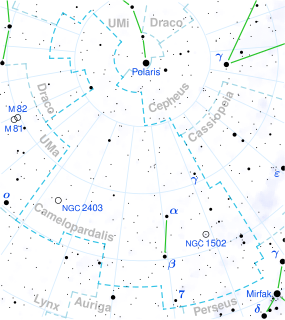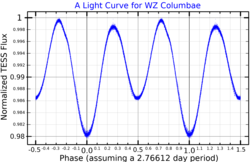
NO Apodis is a solitary, red hued variable star located in the southern circumpolar constellation Apus. It has an average apparent magnitude of 5.86, allowing it to be faintly seen with the naked eye. The object is relatively far at a distance of 790 light years but is drifting closer with a heliocentric radial velocity −18.3 km/s.
CQ Camelopardalis, abbreviated as CQ Cam, is a solitary variable star in the northern circumpolar constellation Camelopardalis. It has an apparent magnitude of 5.19, making it visible to the naked eye under ideal conditions. The object is relatively far at a distance of about 2,000 light years but is drifting closer with a helicoentric radial velocity of −22 km/s. It has a peculiar velocity of 21.8+2.1
−1.9 km/s, making it a runaway star.
HD 27274, also known as Gliese 167, is a solitary, orange hued star located in the southern constellation Dorado. It has an apparent magnitude of 7.63, making it readily visible in binoculars, but not to the naked eye. Based on parallax measurements from the Gaia spacecraft, the star is known to be located 42.5 light-years away from the Solar System However, it is drifting closer with a heliocentric radial velocity of −23 km/s. At its current distance, HD 27274 is dimmed down by 0.05 magnitudes due to interstellar dust.
μ1 Chamaeleontis, Latinized as Mu1 Chamaeleontis, is a single star in the southern circumpolar constellation Chamaeleon. It is dimly visible to the naked eye with an apparent visual magnitude of 5.53. Based upon parallax measurements, it is located approximately 403 light-years away from the Sun. The radial velocity is poorly constrained, but it appears to be drifting further away at the rate of about 16 km/s
HD 96146 is a binary star located in the southern constellation Antlia. The system has a combined apparent magnitude of 5.41, making it visible to the naked eye under ideal conditions. Parallax measurements from the Gaia spacecraft place the pair at a distance of 710 light years with a large margin of error. It is currently receding with a poorly constrained heliocentric radial velocity of 4.7 km/s.
HD 72337, also known as HR 3370, is a solitary, bluish-white hued star located in the southern constellation Volans. With an apparent magnitude of 5.51, it is faintly visible to the unaided eye but only under ideal conditions.

HD 25291, also known as HR 1242, is a solitary, yellowish-white hued star located in the northern circumpolar constellation Camelopardalis. It has an apparent magnitude of 5.12, making it one of the brighter members of this generally faint constellation. The object is relatively far at a distant of approximately 2,100 light years but is drifting closer with a heliocentric radial velocity of −20.3 km/s.

Pi2 Octantis, Latinized from π2 Octantis, is a solitary star situated in the southern circumpolar constellation Octans. It has an apparent magnitude of 5.64, allowing it to be faintly visible to the naked eye under ideal conditions. Located 1,570 light years away, the star is approaching the Sun with a heliocentric radial velocity of −13.8 km/s.
HD 64307, also known as HR 3075, is a solitary, orange hued star located in the northern circumpolar constellation Camelopardalis. It has an apparent magnitude of 5.35, allowing it to be faintly seen with the naked eye. Based on parallax measurements from the Gaia spacecraft, The object is estimated to be 690 light years distant. It appears to be receding from the Sun, having a heliocentric radial velocity of 34 km/s.
HD 170069 is a solitary star in the southern constellation Telescopium. It has an apparent magnitude of 5.68, allowing it to be faintly seen with the naked eye. The star is located at a distance of 590 light years but is approaching closer with a heliocentric radial velocity of −18 km/s. HD 170069 was designated as Tau Telescopii before Benjamin Apthorp Gould dropped the title.
HD 1032 is a solitary star in the southern circumpolar constellation Octans. It is faintly visible to the naked eye with an apparent magnitude of 5.77 and is estimated to be 850 light years away from the Solar System based on parallax measure. However, it is receding with a heliocentric radial velocity of 4 km/s.
HD 89571 is a binary star located in the northern circumpolar constellation Camelopardalis. It is faintly visible to the naked eye with a combined apparent magnitude of 5.51 and is estimated to be 142 light years away from the Solar System. However, it is receding with a heliocentric radial velocity of 3.5 km/s.
HD 10800, also known as HR 512 or Gliese 67.1, is a triple star located in the southern circumpolar constellation Octans. It has a combined apparent magnitude of 5.87, allowing it to be faintly seen with the naked eye. The system is relatively close at a distance of 88.1 light years but is drifting closer with a heliocentric radial velocity −1.1 km/s.

SY Equulei, also known as HD 203664, is a single variable star located in the equatorial constellation Equuleus. It has an average apparent magnitude of about 8.5, varying by a few hundredths of a magnitude, making it readily visible in binoculars and small telescopes, but not to the naked eye. The star is relatively far away at a distance of 8,000 light years and is receding with a heliocentric radial velocity of 48 km/s. At that distance, SY Equulei is dimmed by 0.19 magnitudes due to interstellar dust.
HD 75171, also known as HR 3495, is a solitary, white hued star located in the southern constellation of Volans. It has an apparent magnitude of 6.02, making it faintly visible to the naked eye under ideal conditions. The object is relatively close at a distance of 191 light years but is receding with a heliocentric radial velocity of 10.7 km/s. Eggen (1995) lists it as a probable member of the Hyades Supercluster.
HD 208741, also known as HR 8380, is a yellowish-white hued star located in the southern circumpolar constellation Octans. It has an apparent magnitude of 5.91, making it faintly visible to the naked eye. Parallax measurements place it at a distance of 211 light years, and it is currently receding with a heliocentric radial velocity of 8 km/s.
HD 37289, also known as HR 1916, is a solitary, orange hued star located in the northern circumpolar constellation Camelopardalis. It has an apparent magnitude of 5.61, making it faintly visible to the naked eye under ideal conditions. Based on parallax measurements from the Gaia spacecraft, the object is estimated to be 308 light years distant. It appears to be approaching the Sun, having a heliocentric radial velocity of −20.7 km/s.

AF Columbae, also known as HD 42682, is a solitary, red hued variable star located in the southern constellation Columba, the dove. It has an apparent magnitude that fluctuates between 5.6 and 5.71. Nevertheless, it is faintly visible to the naked eye. Parallax measurements from the Gaia spacecraft place the star relatively far at a distance of 820 light years. However, it is approaching the Solar System with a poorly constrained radial velocity of −19 km/s.
HD 58425, also known as HR 2830, is an astrometric binary located in the northern circumpolar constellation Camelopardalis. It is faintly visible to the naked eye as an orang point of light at an apparent magnitude of 5.64. Based on parallax measurements from Gaia DR3, the system is estimated to be 470 light years away from Earth. It appears to be rapidly receding from the Sun, having a heliocentric radial velocity of 58.6 km/s. HD 58425 is listed as 54 Ursae Majoris in Johann Hevelius' catalogue, but this was dropped after the official IAU's official constellation borders were drawn.
HD 34255, also known HR 1720, is a star located in the northern circumpolar constellation Camelopardalis, the giraffe. It has an apparent magnitude of 5.60, allowing it to be faintly visible to the naked eye. The object is located relatively far at a distance of about 1.65 kly but is approaching the Solar System with a heliocentric radial velocity of −7.7 km/s.





